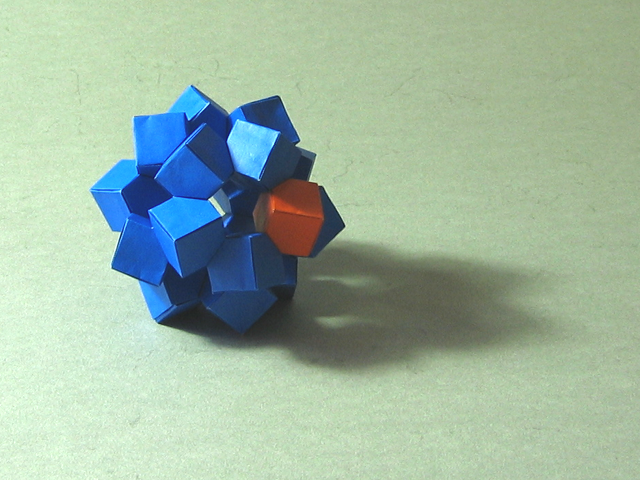
This is surely the biggest modular project I've completed thus far. It needs 120 modules from a square, and 30 hinges from 1 by 4 strips. I decided to make one of the cubes orange, and the rest blue to give the model a focal point.
Francesco taught this model at the CDO Convention 2009, and I completed two of the four rings at the convention, and started on the third one. The model does not need glue to hold together, but I have to admit I glued some modules, so that my work in progress would not fall apart during the travel back to Germany. Yesterday I finished the third and fourth ring. It's probably not a big surprise that it took me less time at home, but I was still happy that the final stage was easier than expected.
People who know me in connection with origami will probably know I'm not the biggest fan of modulars. But the look of the model really intrigued me, and I do feel like I'm warming toward modular origami more with every year that passes. That's not to say that I think I'll ever choose it above folds from a single sheet, but at least I might do modulars a bit more often now. That's especially so, because I'm thinking about making Christmas decorations for next year, and that simply screams modular origami. :)
Paper: 120 x 4cm squares, 30 x 1 by 4cm strips
Model: sphere with a diameter of approx. 9.5cm

Comments
Submitted by Anonymous (not verified) on 10 December 2009 - 8:24pm Permalink
wow!!!
wow. this is awsome.do you know if there are any available diagrams??please reply!!
Submitted by Sara on 14 December 2009 - 8:48am Permalink
Diagrams for David Mitchell's version
I'm not aware of any diagrams for the modification by Francesco Decio. But the original design is by David Mitchell, and diagrams for the cubes can be found in Mathematical Origami: Geometrical Shapes by Paper Folding by David Mitchell. Indeed, the "Look Inside" functionality that Amazon features showed me the diagrams for exactly that cube.
So how does Francesco Decio's version differ from that?
1. The modules are modified slightly. Rather than folding each of the edges to the center in step 7 and 9, you pinch at a quarter, and then fold the edges to that pinch mark. This creates are narrow and a wide tab, rather than two equally big ones.
2. Francesco Decio connects the cubes with a hinge, rather than gluing. For this he uses a 1 by 4 strip and folds in the same height of paper that the smaller of the two tabs from above has. Then the hinge can be inserted into that small tab, and one cube is assembled. Depending on which stage of the model you are at, the hinge has to be inserted in different places of the cube. The other part of the hinge will be placed into one of the larger tabs of a unit. This then locks two cubes together. The lock between cubes is pretty strong, much stronger than that which connects 6 units to a cube.
I'm not sure I want to do a video on this model, mostly because I'd have to spend several hours on folding all the modules and joining them. I'll think about it. And I haven't asked David Mitchell and Francesco Decio in any case yet.
But if you want to fold this model and are not too shy to use glue, you can follow the diagrams David Mitchell made, and glue the cubes, rather than connecting them with hinges.
-- Sara
Submitted by Anonymous (not verified) on 27 June 2011 - 8:33pm Permalink
thank's
thank's sara for the explanation tommorow i am going to start this model and by the way do you know when you are going to make a video on Llopio's Moment of Truth by neal elias.
Submitted by Sara on 2 July 2011 - 5:37pm Permalink
Not now
Sorry, I've got many other things going on in my life right now, and simply don't have the time and patience to make a video on Llopio's Moment of Truth. The time will come, but I fear you'll have to wait some more.
-- Sara
Submitted by Steven (not verified) on 29 June 2011 - 5:23am Permalink
Steven
This is awesome. I am going to start this model and by the way do you know when you are going to make a video on Llopio's Moment of Truth by neal elias. Thank you for the information that you share.
Submitted by Sara on 2 July 2011 - 5:37pm Permalink
Not now
Sorry, I've got many other things going on in my life right now, and simply don't have the time and patience to make a video on Llopio's Moment of Truth. The time will come, but I fear you'll have to wait some more.
-- Sara
Add new comment